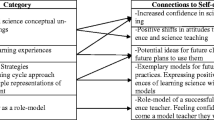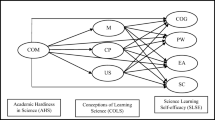Abstract
The purpose of this study was to examine the relationships among science content knowledge, understanding the Learning Cycle, and self-efficacy among preservice teachers. Preservice teachers enrolled in an elementary science-methods course were categorized as Fearful, Disinterested, Successful, or Enthusiastic science learners based on differing background characteristics in the variables of science interest, performance in science courses methods courses. Analysis revealed that the four categories increased differentially in their science content knowledge, understanding of the Learning Cycle, science teaching self-efficacy, and confidence to learn science. Fearful science learners demonstrated less increases in science content knowledge and understanding of the Learning Cycle than the other three categories. Disinterested science learners demonstrated fewer gains in science content knowledge than Enthusiastic science learners. Fearful science learners were less confident to learn science than other categories.
Similar content being viewed by others
References
Bandura, A. (1977). Self-efficacy: Toward a unifying theory of behavioural change. Psychological Review, 84, 191–215.
Bandura, A. (2000). Self-efficacy: Foundation of agency. In: W. Perrig & A. Gorb (Eds.), Control of human behavior, mental processes, and consciousness (pp. 17–33). Mahwah, NJ: Lawrence Erlbaum.
Bleicher, R.E. (2004). Revisiting the STEBI-B: Measuring self-efficacy in preservice elementary teachers. School Science and Mathematics Journal, 104, 383–391.
Bleicher, R.E. & Lindgren, J. (2002). Building confidence in preservice elementary science teachers. In P. Rubba, W. DiBiase, & B. Crawford (Eds.), Proceedings of the 2002 Annual International Conference of the Association for the Education of Teachers in Science (pp. 1593–1606). ERIC Document Reproduction Service No. ED (465602).
Bleicher, R.E. & Lindgren, J. (2005). Success in learning science and preservice science teaching self-efficacy. Journal of Science Teacher Education, 16, 205–225.
Butts, D.P., Koballa, T.R. & Elliot, T.D. (1997). Does participating in an undergraduate elementary science methods course make a difference. Journal of Elementary Science Education, 9, 1–17.
Bybee, R., Taylor, J.A., Gardner, A., Van Scotter, P., Powell, J.C., Westbrook, A. & Landes, N. (2006). The BSCS 5E instructional model, origins, effectiveness, and application. Retrieved from http://www.bscs.org/pdf/bscs5efullreport2006.pdf.
Dansereau, D.F. (1995). Derived structural schemas and the transfer of knowledge. In: A. McKeough, J. Lupart & A. Marini (Eds.), Teaching for transfer: Fostering generalization in learning (pp. 93–121). Mahwah, NJ: Lawrence Erlbaum Associates.
Darling Hammond, L. & Lowenberg Ball, D. (1998). Teaching for high standards: What policymakers need to know and be able to. CPRE Publications, University of Pennsylvania, Graduate School of Education. (ERIC No. ED426491).
DeJong, T. & Ferguson-Hessler, M.G.M. (1996). Types and quality of knowledge. Educational Psychologist, 31(2), 105–113.
Dewey, J. (1938). Experience and education. New York: Touchstone.
Donovan, M.S., Bransford, J.D. & Pellegrino, J.W. (1999).How people learn: Bridging research and practice (National Research Council). Washington, DC: National Academy Press.
Enochs, L. & Riggs, I. (1990). Further development of an elementary science teaching efficacy belief instrument: a preservice elementary scale. School Science and Mathematics, 90, 694–706.
Jarrett, O.S. (1999). Science interest and confidence among preservice elementary teachers. Journal of Elementary Science Education, 11, 49–59.
Karplus, R. & Their, H.D. (1967). A new look at elementary school science. Chicago, IL: R and McNally.
Lawrenz, F. (1986). Misconceptions of physical science concepts among elementary preservice elementary teacher education students. Journal of Research in Science Teaching, 32, 205–222.
Lawson, A.E. (2004). Preserving or intellectual history: The history and development of the learning cycle. Paper presented at the Annual Meeting of the Association for the Education of Teachers of Science. Nashville, TN, January.
Lawson, A.E., Abraham, M.R. & Renner, J.W. (1989). A theory of instruction: Using the Learning Cycle to teach science concepts and thinking skills (Serial No. 1). Monograph of the National Association of Research in Science Teaching.
Lindgren, J. & Bleicher, R.E. (2003). The learning cycle and preservice science teacher self-efficacy. In Proceedings of the Annual International Conference of the National Association for Research in Science Teaching, Philadelphia.
Lindgren, J. & Bleicher, R.E. (2005). Learning the learning cycle: The differential effect on elementary preservice teachers. School Science and Mathematics Journal, 105, 61–72.
Maloney, D.P. & Siegler, R.S. (1993). Conceptual competition in physics learning. International Journal of Science Education, 15, 283–295.
Marek, E.A. & Cavallo, A.M.L. (1997). The Learning Cycle: Elementary school science and beyond (Revised ed.). Portsmouth, NH: Heinemann.
McDermott, L.C. & Shaffer, P.S. (1992). Research as a guide for curriculum development: An example from introductory electricity. Part I: Investigation for student understanding. American Journal of Physics, 60, 994–1003.
Odom, A.L. & Settlage, J. (1996). Teachers’ understanding of the learning cycle as assessed with a two-tiered test. Journal of Science Teacher Education, 7, 123–142.
Palmer, D.H. (2002). Factors contributing to attitude exchange amongst preservice elementary teachers. Science Education, 86, 122–138.
Resnick, L.B. (1989). Knowing, learning, and instruction. Hillsdale, NJ: Erlbaum.
Schoon, K.J. & Boone, W.J. (1998). Self-efficacy and alternative conceptions of science of preservice elementary teachers. Science Education, 82, 553–568.
Settlage, J. (2000). Understanding the learning cycle: Influences on abilities to embrace the approach by preservice elementary school teachers. Science Education, 84, 43–50.
Shulman, L.S. (1987). Knowledge and teaching: Foundations of the new reform. Harvard Educational Review, 57, 1–22.
Tobin, K. & Tippins, D.J. (1993). Constructivism as a referent for teaching and learning. In: K. Tobin (Ed.), The practice of constructivism in science education. Hillsdale, NJ: Erlbaum.
Tosun, T. (2000). The impact of prior science course experience and achievement on the science teaching self efficacy of preservice elementary teachers. Journal of Elementary Science Education, 12, 21–31.
Trundle, K.C., Atwood, R.K. & Christopher, J.E. (2002). Preservice elementay teachers’ conceptions of moon phases before and after instruction. Journal of Research in Science Teaching, 39(7), 633–658.
Watters, J.J. & Ginns, I.S. (2000). Developing motivation to teach elementary science.: Effect of collaborative and authentic learning practice in preservice education. Journal of Science Teacher Education, 11, 301–321.
Author information
Authors and Affiliations
Corresponding author
Additional information
An erratum to this article can be found at http://dx.doi.org/10.1007/s10763-009-9161-3
Rights and permissions
About this article
Cite this article
Bleicher, R.E. Variable Relationships among Different Science Learners in Elementary Science-Methods Courses. Int J of Sci and Math Educ 7, 293–313 (2009). https://doi.org/10.1007/s10763-007-9121-8
Received:
Accepted:
Published:
Issue Date:
DOI: https://doi.org/10.1007/s10763-007-9121-8




